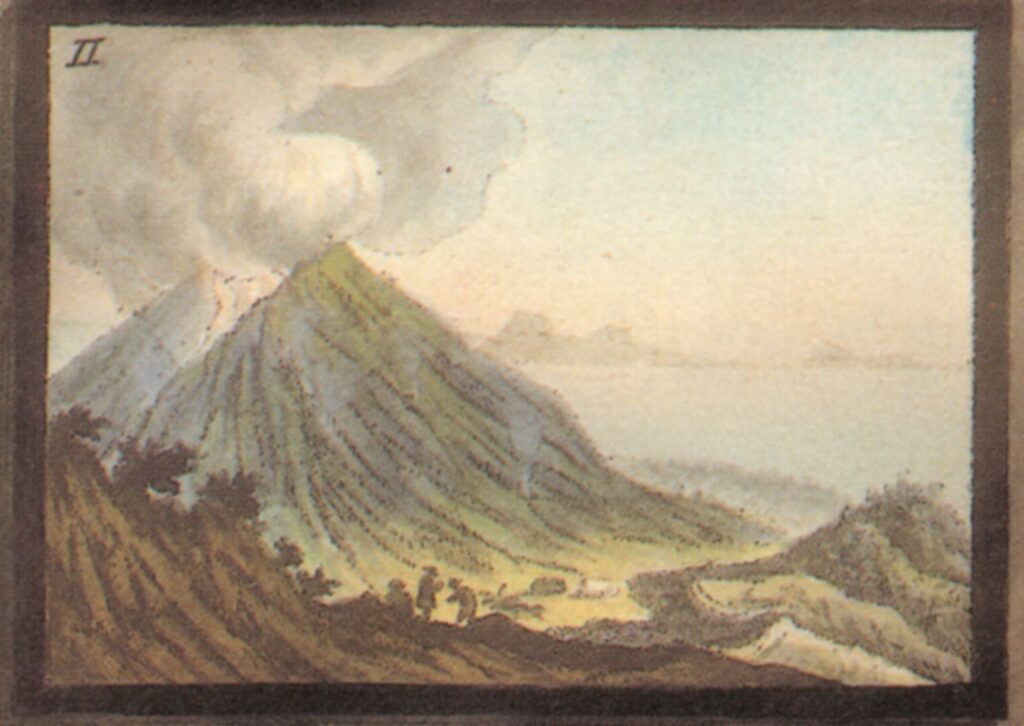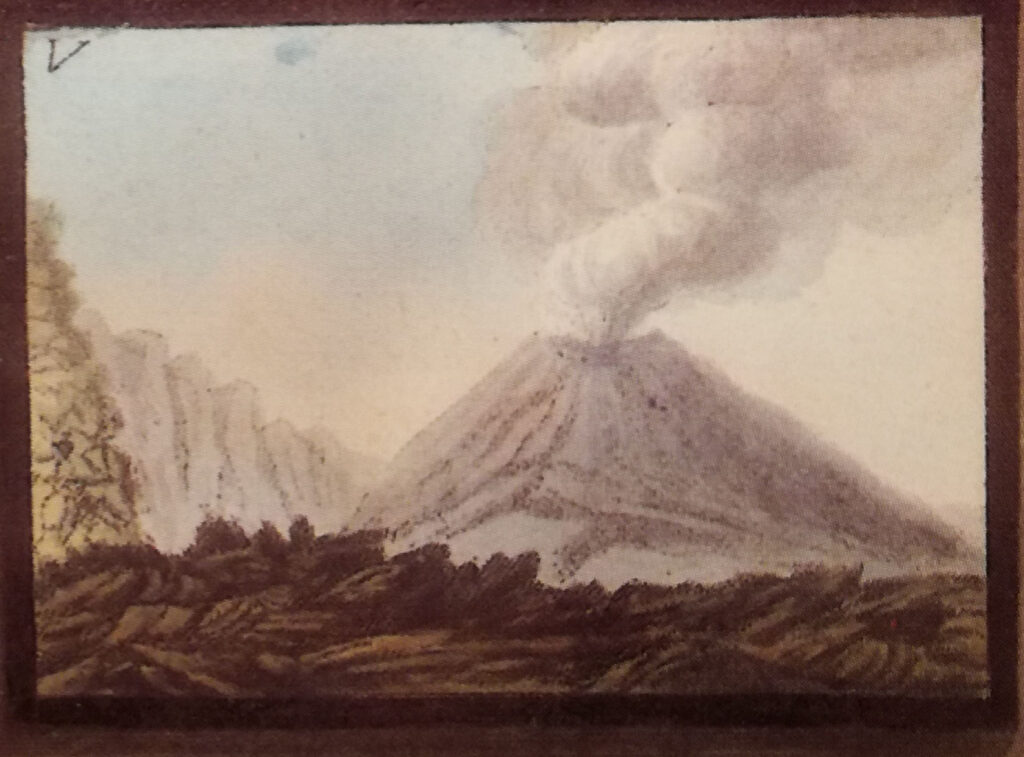William HAMILTON, Supplement to the Campi Phlegraei, Napoli, Pietro FABRIS (editore nel senso di venditore esclusivo), Francesco MORELLI ? (stampatore) 1779. Tavola I fig. II e V. Acqueforti colorate a mano (in genere ad acquerello), cm. 39 x 21,2 (la tavola). Autore delle gouaches originali: Pietro FABRIS. Incisore e coloritore: Anonimo.
Con alcune differenze, la fig. II corrisponde a quella in De Bottis 1779 tav. IV disegnata da Saverio della Gatta. Esistono altre corrispondenze tra le figure in Hamilton 1779 e De Bottis 1779: ad esempio tra Hamilton 1779 tav. I fig. I e De Bottis 1779 tav. II (Toscano 2009). Sulla attribuzione, prima non condivisa, di tutte le tavole di Hamilton a Fabris, cf. Knight 1990, pp. 140 e ss. La fig. V è stilisticamente e tematicamente connessa alla fig. II, ma non è inclusa in De Bottis 1779. La fig. II può essere connessa con le osservazioni effettuate da Hamilton il 18 settembre e riportate nel testo (pp. 22 e ss.). Forse Saverio della Gatta adattò per De Bottis la presente fig. II o forse avvenne il contrario, dato che, in apertura del Supplement (p. I), Hamilton cita con ammirazione l’opera di De Bottis come in corso avanzato di lavorazione: That [description] on which the Abbot Bottis [sic] is actually employ’d by command of His Sicilian Majesty, will undoubtedly be executed with the same accuracy, truth, and precision, as have render’s that Author’s former Publications upon the Subject of Mount Vesuvius so universally and deservedly esteem’d. Such a Publication, executed with magnificence in the Royal printing Office, may perhaps, render every other account of the late Eruption superfluous…
Bibliografia. Sulle vicende editoriali e le tecniche esecutive: Knight 2000, in part. pp. 34-35; Jenkins and Sloan 1996, in part. 165-7. Su Hamilton: Knight 1990; Moore 1994; Thackray 1996; Wood 2006. Sulla eruzione del 1779: Nazzaro 2001, pp. 163-6; Imbò 1984, p. 101; Lirer et al. 2005, p. 59; Ricciardi 2009, pp. 401-11. Su Hamilton e De Bottis: Toscano 2009, pp. 42-50. Sulle rappresentazioni temporali del Vesuvio: Laurenza 2025.
MUTAMENTI OROGRAFICI
Cono: distruzione
Specie dal confronto con la fig. IV che, inclusa nella stessa tavola I, rappresenta il Vesuvio prima della eruzione, nella fig. II è visibile la decurtazione obliqua di un lato della sommità craterale. Cf. anche Hamilton 1779 tav. II e III e De Bottis 1779 tav. IV.
[p. 23] the form of the crater is changed, a great piece of it’s rim towards Somma being wanting, and on the side towards the sea it is also broken. There are some very large cracks towards the point of the cone of the Volcano…
Colate laviche solidificate
Anche se in modo meno chiaro che in De Bottis 1779 tav. IV, è riconoscibile una delle due colate laviche solidificate che invase il vallone tra Vesuvio e Somma.
[p. 23] the valley between Vesuvius and Somma has received such a prodigious quantity of lava, and other volckanick matter during the last eruption, that is is reaised, as is imagined 250 feet, or more, three such eruptions as the last wou’d compleatly fill up the cavvey, and by uniting Vesuvius and Somma form them into one Mountain, as they most probably were before the great eruption in the Reign of Titus.
ROCCE E DEPOSITI
Blocchi
Nella fig. IV, come in De Bottis 1779 tav. IV, sono rappresentati due enormi blocchi caduti al centro del vallone nel corso della eruzione.
[p. 24] The number and size of the stones, or more properly speaking, of the fragments of lava, which have been thrown out of the Volcano … and which lie scattered thick on the cone of Vesuvius, and at the foot of it, is really incredible. The largest we measured was in circumference no less than 108 english feet and 17 feet high….An other solid block on ancient lava 66 feet in circumference, and 19 feet high, being nearly of a spherical shape, was thrown out at the same time, and lies near the former…..
Domenico Laurenza


